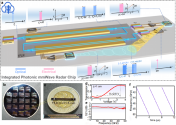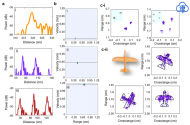Well, I think there's a reason many choose to remain in the U. S. So it's wrong to blame them.Any Chinese scientist working for the US Department of Defense on classified projects is doing so with the knowledge that it is likely to be used against China. From the CIA’s perspective, such people are either traitors to their race, or spies; so this is the expected treatment, I don’t know why they’d have believed otherwise.
You’re not American just because you hold a pass port and worship the West. People will judge you for your choices in relation to your race & ethnicity. For a true white American nationalist, a race traitor is the lowest of trash. So you will be treated accordingly.
You are using an out of date browser. It may not display this or other websites correctly.
You should upgrade or use an alternative browser.
You should upgrade or use an alternative browser.
News on China's scientific and technological development.
- Thread starter Quickie
- Start date
Equation
Lieutenant General
So that they can become Christian and White enough to make fun of other "poor and dirty Chinese" from the mainland. Yeah I think that Joy Luck Club train had passed a long time ago.Well, I think there's a reason many choose to remain in the U. S. So it's wrong to blame them.
A modern tech Jim Crow.
This how the treatment of Chinese researchers have devolve to in US universities, they are being treated like third rate class people for contributing their brain power to the US. For doing fundamental public research <Because the paper was going to be published anyways> no even classify research.
View attachment 144593
View attachment 144594
Good. That's exactly the behavior which will continue to drive talent back home. Which has been happening for years now.
Pull factors are already there, as shown by this Deepseek example. Push factors only help.
Also someone else provided the source article already, but you should really include it when you are quoting from it.
So that they can become Christian and White enough to make fun of other "poor and dirty Chinese" from the mainland. Yeah I think that Joy Luck Club train had passed a long time ago.
You forget that competition in China is extremely high and work is very fast paced. Not everyone can adapt to these conditions.
In4ser
Junior Member
I believe the term in business is literally called a “Chinese Wall”A modern tech Jim Crow.
This how the treatment of Chinese researchers have devolve to in US universities, they are being treated like third rate class people for contributing their brain power to the US. For doing fundamental public research <Because the paper was going to be published anyways> no even classify research.
View attachment 144593
View attachment 144594
Chinese scientists from Nankai university and City University of Hong Kong created an integrated mmWave photonic radar on 4" wafer of lithium niobate thin film, with centimetre level precisions in range finding and target speed measurements, and centimetre level resolution in inverted SAR imaging. This is so far the highest resolution and degree of integration of system-on-chip photonic radars.
Paper in English:
Millimetre-wave (mmWave) radars are key enabler in the upcoming 6G era for high-resolution sensing and detection. Conventional photonic radars are mostly realized in tabletop systems composed of bulky discrete components, whereas the more compact integrated photonic radars are difficult to reach the mmWave bands owing to the unsatisfactory bandwidths and signal integrity of the underlying electro-optic modulators. Here we overcome these challenges and demonstrate a centimetre-resolution compact photonic mmWave radar based on a 4-inch wafer-scale thin-film lithium niobate (TFLN) technology. The TFLN photonic chip consists of a first electro-optic modulator for generating broadband radar waveforms via optical frequency multiplication, and a second modulator for de-chirping the received echoes. This greatly relieves the bandwidth requirements for the digital-to-analogue converter in the transmitter and analogue-to-digital converter in the receiver. Operating in the mmWave V band (40–50 GHz), we achieve multi-target ranging with a resolution of 1.50 cm and velocity measurement with a resolution of 0.067 m s−1. Furthermore, we construct an inverse synthetic aperture radar with a two-dimensional resolution of 1.50 cm × 1.06 cm. Our integrated TFLN photonic mmWave radar chip provides a compact and cost-effective solution in the 6G era for high-resolution sensing and detection in vehicle radar, airborne radar and smart homes.
News in Chinese:
南开大学智能光子研究院祝宁华院士团队与香港城市大学合作,首次设计并构建了集成薄膜铌酸锂光子毫米波雷达,实现了高达厘米级的距离与速度探测分辨率,同时在逆合成孔径雷达二维成像中也达到了厘米级的卓越分辨率,成功突破了电子雷达低频段窄带宽的瓶颈,大幅提升了光子雷达的分辨率和集成度,是目前分辨率最高的片上光子雷达。1月27日,此研究成果发表于国际顶级期刊《自然-光子学》上。


Another news report:
研究团队通过紫外步进式光刻技术和干法刻蚀工艺的参数迭代优化,基于兼容CMOS工艺的4英寸薄膜铌酸锂平台的加工制备技术,成功制备了集成倍频模块和回波去斜模块的片上光子毫米波雷达芯片,在片上高效地实现毫米波雷达信号的生成与目标回波的处理,突破先进制程下高速数模/模数转换器性能不足对雷达整体性能提升的限制。
Paper in English:
Millimetre-wave (mmWave) radars are key enabler in the upcoming 6G era for high-resolution sensing and detection. Conventional photonic radars are mostly realized in tabletop systems composed of bulky discrete components, whereas the more compact integrated photonic radars are difficult to reach the mmWave bands owing to the unsatisfactory bandwidths and signal integrity of the underlying electro-optic modulators. Here we overcome these challenges and demonstrate a centimetre-resolution compact photonic mmWave radar based on a 4-inch wafer-scale thin-film lithium niobate (TFLN) technology. The TFLN photonic chip consists of a first electro-optic modulator for generating broadband radar waveforms via optical frequency multiplication, and a second modulator for de-chirping the received echoes. This greatly relieves the bandwidth requirements for the digital-to-analogue converter in the transmitter and analogue-to-digital converter in the receiver. Operating in the mmWave V band (40–50 GHz), we achieve multi-target ranging with a resolution of 1.50 cm and velocity measurement with a resolution of 0.067 m s−1. Furthermore, we construct an inverse synthetic aperture radar with a two-dimensional resolution of 1.50 cm × 1.06 cm. Our integrated TFLN photonic mmWave radar chip provides a compact and cost-effective solution in the 6G era for high-resolution sensing and detection in vehicle radar, airborne radar and smart homes.
News in Chinese:
南开大学智能光子研究院祝宁华院士团队与香港城市大学合作,首次设计并构建了集成薄膜铌酸锂光子毫米波雷达,实现了高达厘米级的距离与速度探测分辨率,同时在逆合成孔径雷达二维成像中也达到了厘米级的卓越分辨率,成功突破了电子雷达低频段窄带宽的瓶颈,大幅提升了光子雷达的分辨率和集成度,是目前分辨率最高的片上光子雷达。1月27日,此研究成果发表于国际顶级期刊《自然-光子学》上。


Another news report:
研究团队通过紫外步进式光刻技术和干法刻蚀工艺的参数迭代优化,基于兼容CMOS工艺的4英寸薄膜铌酸锂平台的加工制备技术,成功制备了集成倍频模块和回波去斜模块的片上光子毫米波雷达芯片,在片上高效地实现毫米波雷达信号的生成与目标回波的处理,突破先进制程下高速数模/模数转换器性能不足对雷达整体性能提升的限制。
Scientists from China published a deep learning framework to predict virus variation drivers that works for influenza, zika, covid and HIV. Notably, the software and the model are developed on the domestic Exa-scale AI compute cluster in the Pengcheng lab. An earlier stage milestone of this work was nominated for the Gordon Bell prize in 2022.
Paper in English:
News in Chinese:
鹏城实验室-北京大学联合团队与广州实验室研究员周鹏团队合作,研究实现了跨病毒类型和跨毒株的通用预测,涵盖新冠、流感、寨卡和艾滋病病毒,展现了AI助力自然科学研究范式革新的巨大潜力。近日,相关成果发表于《自然-机器智能》(Nature Machine Intelligence)。
2024年诺贝尔物理学奖和化学奖双双花落AI领域——物理学奖突出表彰“Science如何应用并改变AI”, 化学奖突出展现“AI如何改变科学和人们的认知”,将AI4S的研究热度推上新高潮——AI4S成为了学界前沿趋势,并正在推动科学研究范式的变革。
研究团队基于进化论和表观遗传学重新审视进化预测难题,从宏观进化角度凝练了病毒进化的两大本质问题,通过“微弱突变放大”和“稀少有益突变挖掘”两个创新设计实现了跨病毒类型和跨毒株的通用预测,涵盖新冠、流感、寨卡和艾滋病病毒,该研究实现了不同尺度的病毒进化预测,展现了自然科学和AI架构的高度融合,为疫苗、药物的快速主动更新以及提高人类对于新发病毒感染的响应速度提供了强大工具,支撑和加速对于物种复杂进化机制的探索。未来可与疫苗和蛋白类药物设计流程相结合,有望提升设计效率和设计可控度。
国产E级智算平台“鹏城云脑Ⅱ”支撑了模型训练及验证,保障了模型的快速部署。研究团队通过多层次联合优化高性能计算策略实现了模型的高效并行训练和微调,有力支撑了该研究的顺利进行和发表,充分展现了国产自主可控AI算力平台的先进性和优越性。
值得一提的是,鹏城实验室研究员高文、田永鸿、陈杰团队一直致力于推动AI4S的发展,团队前期成果曾入围2022年度戈登贝尔特别奖,与世界一流科研团队在世界顶级平台上角逐这一超级计算机领域的国际最高奖项,团队于众多世界级顶尖强队中脱颖而出名列前茅,展现出中国人工智能在计算集群和科研创新领域的全球顶尖水平。
Paper in English:
A unified evolution-driven deep learning framework for virus variation driver prediction
The increasing frequency of emerging viral infections necessitates a rapid human response, highlighting the cost-effectiveness of computational methods. However, existing computational approaches are limited by their input forms or incomplete functionalities, preventing a unified prediction of diverse virus variation drivers and hindering in-depth applications. To address this issue, we propose a unified evolution-driven framework for predicting virus variation drivers, named Evolution-driven Virus Variation Driver prediction (E2VD), which is guided by virus evolutionary traits. With evolution-inspired design, E2VD comprehensively and significantly outperforms state-of-the-art methods across various virus mutational driver prediction tasks. Moreover, E2VD effectively captures the fundamental patterns of virus evolution. It not only distinguishes different types of mutations but also accurately identifies rare beneficial mutations that are critical for viruses to survive, while maintaining generalization capabilities across different lineages of SARS-CoV-2 and different types of viruses. Importantly, with predicted biological drivers, E2VD perceives virus evolutionary trends in which potential high-risk mutation sites are accurately recommended. Overall, E2VD represents a unified, structure-free and interpretable approach for analysing and predicting viral evolutionary fitness, providing an ideal alternative to costly wet-lab measurements to accelerate responses to emerging viral infections.News in Chinese:
鹏城实验室-北京大学联合团队与广州实验室研究员周鹏团队合作,研究实现了跨病毒类型和跨毒株的通用预测,涵盖新冠、流感、寨卡和艾滋病病毒,展现了AI助力自然科学研究范式革新的巨大潜力。近日,相关成果发表于《自然-机器智能》(Nature Machine Intelligence)。
2024年诺贝尔物理学奖和化学奖双双花落AI领域——物理学奖突出表彰“Science如何应用并改变AI”, 化学奖突出展现“AI如何改变科学和人们的认知”,将AI4S的研究热度推上新高潮——AI4S成为了学界前沿趋势,并正在推动科学研究范式的变革。
研究团队基于进化论和表观遗传学重新审视进化预测难题,从宏观进化角度凝练了病毒进化的两大本质问题,通过“微弱突变放大”和“稀少有益突变挖掘”两个创新设计实现了跨病毒类型和跨毒株的通用预测,涵盖新冠、流感、寨卡和艾滋病病毒,该研究实现了不同尺度的病毒进化预测,展现了自然科学和AI架构的高度融合,为疫苗、药物的快速主动更新以及提高人类对于新发病毒感染的响应速度提供了强大工具,支撑和加速对于物种复杂进化机制的探索。未来可与疫苗和蛋白类药物设计流程相结合,有望提升设计效率和设计可控度。
国产E级智算平台“鹏城云脑Ⅱ”支撑了模型训练及验证,保障了模型的快速部署。研究团队通过多层次联合优化高性能计算策略实现了模型的高效并行训练和微调,有力支撑了该研究的顺利进行和发表,充分展现了国产自主可控AI算力平台的先进性和优越性。
值得一提的是,鹏城实验室研究员高文、田永鸿、陈杰团队一直致力于推动AI4S的发展,团队前期成果曾入围2022年度戈登贝尔特别奖,与世界一流科研团队在世界顶级平台上角逐这一超级计算机领域的国际最高奖项,团队于众多世界级顶尖强队中脱颖而出名列前茅,展现出中国人工智能在计算集群和科研创新领域的全球顶尖水平。
Xiaomi testing its smart AC in -35 C in Heilongjiang. What an incredible company in getting into some many products and raising standards.
Lethe
Captain
I notice that ASPI's Critical Technology Tracker was updated in August 2024. The ASPI tracker looks at high-impact published research (top 10% of papers by number of citations) across a variety of technologies, as a leading indicator of potential medium- and long-term developments.
Over the period 2019-2023, China is assessed as the leading source of high-impact research in 57 of the 64 categories assessed, with the United States leading in the remaining 7 categories: Quantum computing, vaccines and medical countermeasures, atomic clocks, genetic engineering, small satellites, nuclear medicine and radiotherapy, and natural language processing. Notably, all but quantum computing is at <2:1 US:China ratio of published papers, and NLP is basically a tie. Conversely, China not only leads in many more fields, but has significantly stronger leads in many of those fields, with 24 of the 57 categories that China leads having a >3:1 ratio of published research and 8 or more of the top 10 institutions in that field.
Obviously there are many limitations to this data and nuances in interpreting it. The full report is worth reading in that regard.
Over the period 2019-2023, China is assessed as the leading source of high-impact research in 57 of the 64 categories assessed, with the United States leading in the remaining 7 categories: Quantum computing, vaccines and medical countermeasures, atomic clocks, genetic engineering, small satellites, nuclear medicine and radiotherapy, and natural language processing. Notably, all but quantum computing is at <2:1 US:China ratio of published papers, and NLP is basically a tie. Conversely, China not only leads in many more fields, but has significantly stronger leads in many of those fields, with 24 of the 57 categories that China leads having a >3:1 ratio of published research and 8 or more of the top 10 institutions in that field.
Obviously there are many limitations to this data and nuances in interpreting it. The full report is worth reading in that regard.
Last edited:
